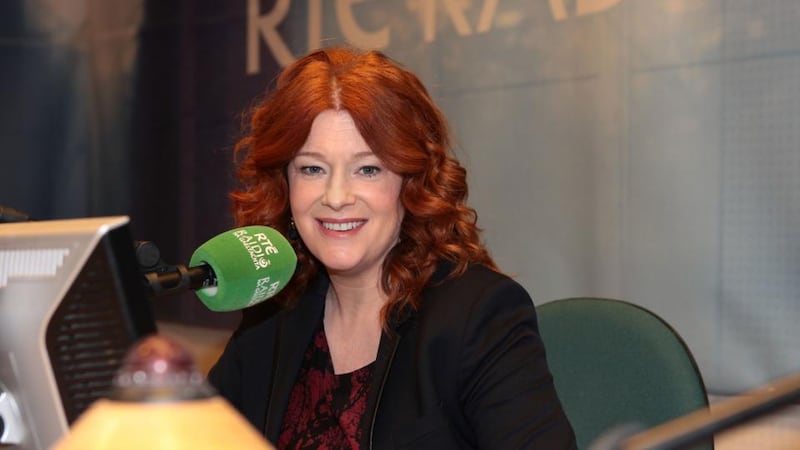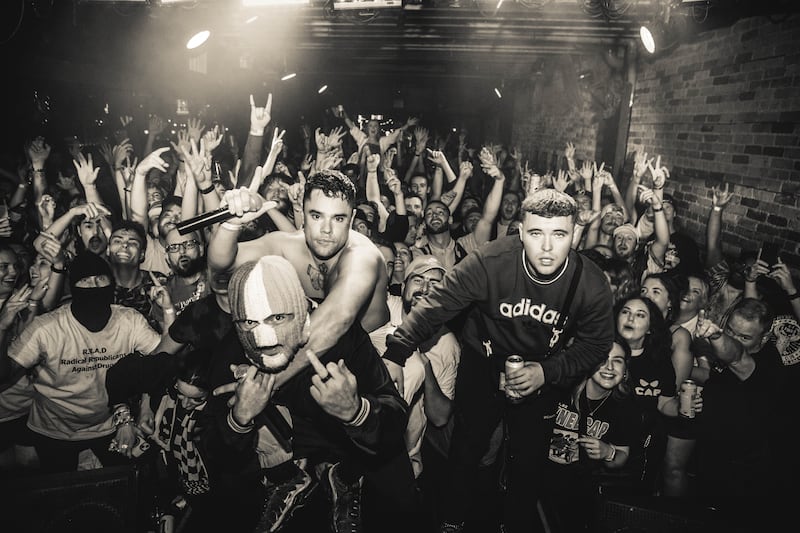The first sentence – if you could even call it that – I learned as Gaeilge that held any real meaning in my life was “stop ag brú” [stop pushing]. I was 12 years old. There were the usuals before that in primary school; asking permission to go to the bathroom, stringing together rudimentary biographical details in rote-learning boredom. But none of these were real. As a child growing up in Deansgrange, Co Dublin, and attending an English-speaking primary school in Foxrock, there was a sense of artifice to the language. It existed only on the page, as a performance, or something to achieve a tick in a copybook for. But when I got to Coláiste Íosagáin, with little of the language on my lips, never mind in my mind, and far away from my soul, I realised all these clunky, vaguely tourist-phrase-book terms I had semi-learned were largely meaningless. What meant something was how to get people to stop squashing me in front of the lockers between classes when books needed to be got. And so, “stop ag brú” came to my rescue.
In this environment, in a then incredibly strict school off the Stillorgan dual-carriageway, Irish was no longer an academic exercise, but a genuine mode of communication, something that came naturally to those who already had it, yet rendered me somewhat mute. Learning through immersion is difficult, but it did happen.
After the first few months in school, something shifted in my unconscious mind. I realised my dreams were happening as Gaeilge. My brain was changing, subsuming the language I was surrounded by in the morning and afternoon, the language I wrote my homework in that evening.
It wasn’t the teachers who inspired a love and appreciation for the language, it was my classmates. Many of them had attended Irish-speaking primary schools. They had their own code within a code; slang and songs, puns and shorthand. Some were native speakers, even though there exists a sort of national ignorance or even denial that many native Irish speakers are born and grow up in Dublin. Our dear departed friend, Éabha Rosenstock, had an especially incredible grasp of the language.
READ MORE
[ Manchán Magan was one of the people who helped me appreciate my mongrel Irish ]
As teenagers, we were all political and, for me, the language was becoming core to my political and cultural identity. Coláiste Eoin, the boy’s school on the same grounds – our classes desegregated by gender after a few years – appeared to operate in an entirely different universe with ludicrous proximity; more bohemian, with a huge focus on music, from which members of My Bloody Valentine, The Frames, Hothouse Flowers, Moving Hearts, The Bonny Men, Kíla, and many more emerged. This mix of music, language, politics, and an outsiderness in the geographical context, had an almost activist stance. We would take it upon ourselves to articulate this in a variety of ways, such as when myself and a friend, Aoife de Búrca, just kids, wrote to the BBC admonishing Blue Peter for broadcasting a flattering item on Oliver Cromwell (the programme subsequently offered a halfhearted apology to its Irish viewers).
In TG4, I often felt nervous, awkward, lacking in confidence. At one point, with reference to a local bus route, I was told I had ‘46A Irish’
I don’t know why I kept my Irish up after school, but I think it was the context. The Catholic part of Irish identity was already being shed. The Celtic Tiger was instilling a sort of confidence that, while misguided in its hyper-capitalism, ensured most of us would be part of a generation not forced to emigrate, at least at that point. It was also down to the industry I entered. Media in Ireland is a place where someone with Irish can get work through the language. Researchers and producers for TG4, Raidió na Gaeltachta, and Raidió na Life know which journalists can speak it.
I got a side gig as the presenter and music producer for an alternative music programme on TG4 called Ceol ar an Imeall. The pitch was to gather emerging, often experimental Irish acts, film them playing live sessions in studio in Connemara, interview international musicians, and then I’d do the links as Gaeilge. The show was kind of crazy, but it worked. In TG4, a new version of that feeling of outsiderness emerged. In the mix with native speakers and those much more fluent and expert than I, I often felt nervous, awkward, lacking in confidence. At one point, with reference to a local bus route, I was told I had “46A Irish”. This was framed as a pejorative, obviously. This experience is past tense, and such attitudes have changed.
[ Why does Cromwell have such a hold on the Irish psyche?Opens in new window ]
In my 20s, I became convinced that by the time my generation were into our 30s and got to break down some doors, when various waves of urban daltaí of Gaelscoileanna came of age, the language could become popularised in a different way. I learned to love my 46A Irish. It is what it is, and it’s mine.

One of the people who helped me appreciate my mongrel Irish, its smorgasbord honed by teachers from Connemara, west Kerry, Dublin and Donegal, was Manchán Magan. Over the years, whenever we bumped into each other at parties or plays, festivals or book launches, we’d speak as Gaeilge, and discuss whatever fragments of contemporary culture related to the language were emerging. Some of these initiatives often felt a little didactic – a version of the primary school lessons versus the necessity at the lockers. But in time, while the Gaeltacht areas of Ireland kept the language alive, a new authenticity in non-Gaeltacht areas also emerged. Manchán’s books – Thirty-Two Words for Field, Listen to the Land Speak – are core to the new wave. Bláthnaid Ní Chofaigh, a native speaker, was another touchstone. Her passion for the language has never dissipated.
[ Kneecap in Dublin: It’s not rage that the punk-rap three-piece conjure. It’s joyOpens in new window ]
Over time, the language’s broader relevance began to feel less like an aspiration or an insistence. One of the reasons the film An Cailín Ciúin is so important, is not just down to its use of the language, but how the language forms an essential part of its cinematic aesthetic. The release in 2024 of Belfast rappers Kneecap’s debut album and film will be a landmark moment for the Irish language in pop culture. Just you wait.
Her Donegal accent never left, it was stored in her Irish vocabulary, kept there, suspended, until it could emerge again, decades later.
Now, that code within a code I longed for as a 12-year-old is being made contemporary. I see Dublin friends with no Irish going to the Gaeltacht to learn it. Our conversations are peppered with Irish. I see and hear the language everywhere in Dublin, where “see ya” is replaced with “slán”, where leaving the pub, club or party late means a hug and “oíche mhaith, coladh sámh”. Where rappers such as Selló weave it into their work. Where people have Duolingo on the go. Bit by bit. This matters. Ultimately, my own Irish isn’t great. I have a long way to go to be the speaker I want to be. But I’m not going to let it go. It means too much. And I’m not framing my personal experience and its detail as universal, it’s merely my own version of events. But when I hear Irish being spoken now, a word or sentence thrown in here or there, I don’t hear reticence. I hear joy and enthusiasm. I don’t feel the energy of strictness, but a looseness to the remix. I don’t hear people slagging Irish off – such a tired, immature, insecure, boring stance – but people wishing they had it.

During the pandemic, myself and my wife decided to speak Irish more at home. She grew up in Falcarragh in the Donegal Gaeltacht, but says during her schooling, the strictness regarding speaking Irish was nowhere near what I experienced far away in Dublin. Having now spent much more time living in Dublin than in the northwest of Ireland, her Donegal accent has dissipated. This, she says, is also a consequence of the ignorance of many middle-class Dubliners she met when she arrived in the capital as a teenager, with people often making fun of her accent, and repeating her own pronunciations back to her. This is something that is especially imposed on people from Donegal and the North. When I hear people doing this to anyone, a genuine rage simmers within me. Now, she experiences a double denial. Because her accent has neutralised, she often deals with: “you don’t sound like you’re from Donegal!”
But when we started speaking Irish together, a strange thing happened. Her Irish is, obviously, Donegal Irish, and in it, is her accent. So her Donegal accent never left, it was stored in her Irish vocabulary, kept there, suspended, until it could emerge again, decades later. She didn’t realise this until I told her: “you know you still have your accent, right? It’s just in your Irish.”
This experience as metaphor is pretty on the nose. And yet it offers us a clear instruction: the opportunity to explore the hidden, frozen, unearthed, or yet-to-be-learned capacity anyone on or of this island has – new, old, emigrant, immigrant – to unlock and enliven this core part of us.
- Sign up for push alerts and have the best news, analysis and comment delivered directly to your phone
- Find The Irish Times on WhatsApp and stay up to date
- Our In The News podcast is now published daily – Find the latest episode here











